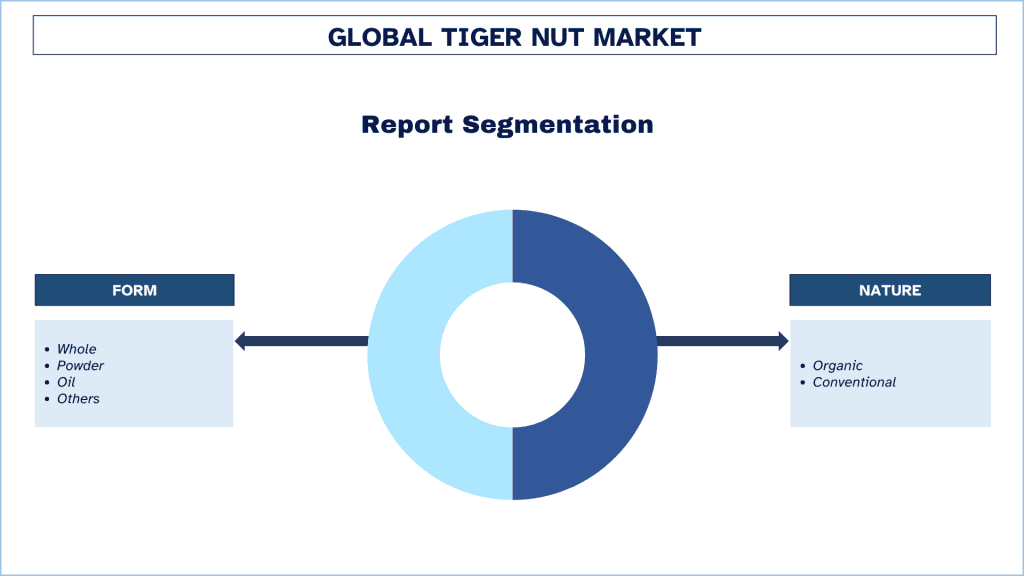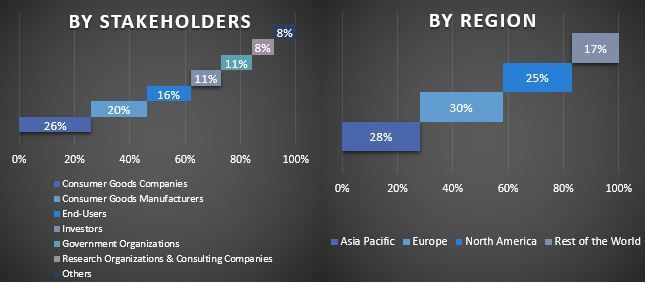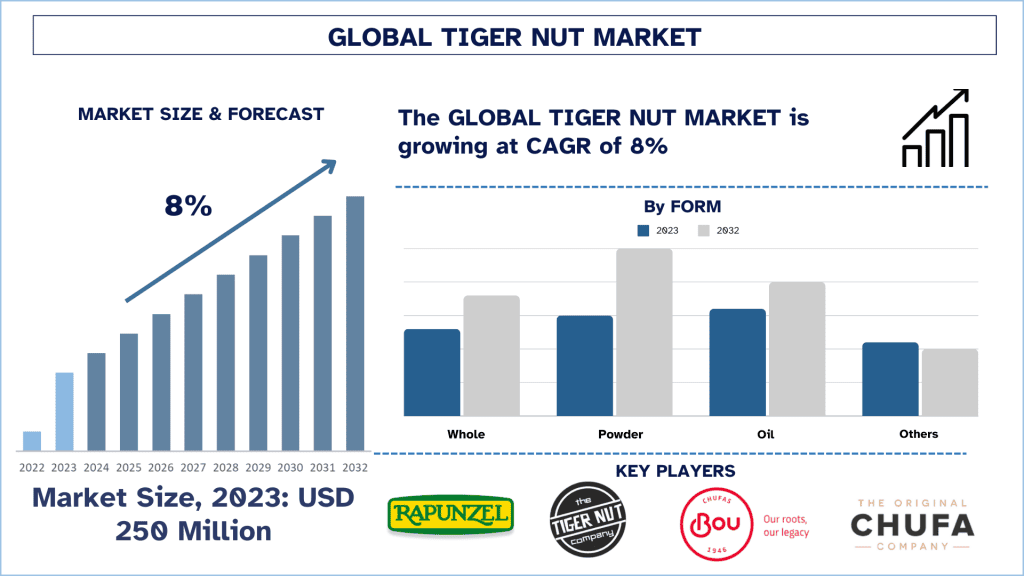- Home
- About Us
- Industry
- Services
- Reading
- Contact Us
Tiger Nut Market: Current Analysis and Forecast (2024-2032)
Emphasis on Form (Whole, Powder, Oil, and Others); Nature (Organic and Conventional); and Region/Country
Tiger Nut Market Size & Forecast
The tiger nut market was valued at approximately ~USD 250 million in 2023 and is expected to grow at a strong CAGR of around 8% during the forecast period (2024-2032) owing to the consistency in demand for functional foods.
Tiger Nut Market Analysis
The market for tiger nuts has expanded in the last few years due to improving consumer knowledge regarding the health benefits associated with tiger nuts, as well as the growing trend of health consciousness along with the consumption of natural and plant-based products. The expansion is further affirmed through tiger nuts enriched profile of nutrition, which comprises fibers, vitamins, and minerals. They are being incorporated into different foods such as snack foods, breakfast cereals, and even plant-based milk such as horchata. Company collaborations, acquisitions, and innovative product launches drive the industry’s growth.
For instance, in January 2023, U.S.-based Sprouts Farmers Market launched an exclusive line of tiger nut products in all locations. The new tiger nut line was a result of Sprouts’ commitment to bringing new health trends to its customers and delighting shoppers with unique, health-focused finds.
Also, according to an article published by the Multidisciplinary Digital Publishing Institute (MDPI) in February 2022, tiger nuts are widely cultivated around the world, it has many nutrients that can be deeply explored and contains 22.14–44.92% lipids, 3.28–8.45% proteins, 23.21–48.12% starch, 8.26–15.47% fibers, and 1.60–2.60% ashes.
Tiger Nut Market Trends
This section discusses the key market trends that are influencing the various segments of the tiger nut market, as identified by our team of research experts.
Powder Segment Transforming Industry
The tiger nut powder market has also expanded substantially as people want healthier food items that are easy to prepare. Tiger nut flour is obtained by reducing tiger nuts into fine powder which makes it easier to apply in different recipes. This segment is affiliated with the global trends in functional foods and the shift towards plant-based diets where consumers look for healthy food with ease of preparation. Tiger nut powder is well appreciated and widely used in making smoothies, baking, and dietary supplements due to its rich fiber content as well as vitamins and minerals. The development in this segment is also due to innovation in the technology of production of the products and new physical and packaging forms that make consumers go for the products. Moreover, the appearance of gluten-free and organic food trends corresponds to the characteristics of tiger nut powder thus strengthening the demand for it. The segment comprising tiger nut powder is also projected to grow as the consumer interest and demand for healthy, plant-based ingredients is on the rise hence presenting a possibility for more branded as well as up-and-coming companies to enter the market.

Europe held the maximum share of the market in the year 2023
Within Europe, Germany is expected to hold a major share of the market in the forecast period. The region’s rapid urbanization, growth in awareness regarding the health benefits of tiger nuts, the growing demand for nutritional products, innovative marketing strategies, company acquisitions, and the presence of several market players are the major factors boosting the market’s growth in the country.
- According to an article published in the National Institute of Health in March 2022, tiger nut has become an important crop of the Spanish Mediterranean region with an annual production of 9000 metric tons and importations of another 2300 tons of tubers from African countries.
- In June 2021, Europe-based DIA launched new products, such as the tiger nut-based soft drink horchata. The company has tweaked the traditional recipe to achieve a high-quality product with packaging that is true to the Mediterranean style.

Tiger Nut Industry Overview
The tiger nut market is competitive, with several global and international market players. The key players are adopting different growth strategies to enhance their market presence, such as partnerships, agreements, collaborations, new product launches, geographical expansions, and mergers and acquisitions. Some of the major players operating in the market are KCB International B.V.; The Tiger Nut Company Ltd; José María Bou, S.L.; The Chufa Original Company; Levantex; Rapunzel Naturkost; TRADIN ORGANIC AGRICULTURE B.V.; XUFEX; TOOTSI IMPEX Inc.; Ecoideas.
- In April 2024, in a bold move to promote local produce consumption to drive national growth, Ghana-based McBerry, a visionary brand under Twellium Industrial Company Limited known for the manufacturing of Biscuits and Confectioneries, introduced its latest biscuit innovation – ‘Tigernut Biscuits’. This delectable new addition aims to promote on a global scale, the commercial utilization of Ghana’s local produce, ‘Tiger Nut’, showcasing to the world its rich local food as a way of promoting the Ghanaian heritage.
- In September 2022, S.-based Sweet Aya introduced its Tiger Nut snacks in multiple flavors including dark chocolate covered, sea salt roasted, etc.
Tiger Nut Market Report Coverage

Reasons to buy this report:
- The study includes market sizing and forecasting analysis validated by authenticated key industry experts.
- The report presents a quick review of overall industry performance at one glance.
- The report covers an in-depth analysis of prominent industry peers with a primary focus on key business financials, product portfolios, expansion strategies, and recent developments.
- Detailed examination of drivers, restraints, key trends, and opportunities prevailing in the industry.
- The study comprehensively covers the market across different segments.
- Deep dive regional level analysis of the industry.
Customization Options:
The global tiger nut market can further be customized as per the requirement or any other market segment. Besides this, UMI understands that you may have your own business needs, hence feel free to connect with us to get a report that completely suits your requirements.
Table of Content
Research Methodology for the Tiger Nut Market Analysis (2024-2032)
Analyzing the historical market, estimating the current market, and forecasting the future market of the global tiger nut market were the three major steps undertaken to create and analyze the adoption of tiger nut in major regions globally. Exhaustive secondary research was conducted to collect the historical market numbers and estimate the current market size. Secondly, to validate these insights, numerous findings and assumptions were taken into consideration. Moreover, exhaustive primary interviews were also conducted, with industry experts across the value chain of the global tiger nut market. Post assumption and validation of market numbers through primary interviews, we employed a top-down/bottom-up approach to forecasting the complete market size. Thereafter, market breakdown and data triangulation methods were adopted to estimate and analyze the market size of segments and sub-segments of the industry pertains to. Detailed methodology is explained below:
Analysis of Historical Market Size
Step 1: In-Depth Study of Secondary Sources:
A detailed secondary study was conducted to obtain the historical market size of the tiger nut market through company internal sources such as annual reports & financial statements, performance presentations, press releases, etc., and external sources including journals, news & articles, government publications, competitor publications, sector reports, third-party database, and other credible publications.
Step 2: Market Segmentation:
After obtaining the historical market size of the tiger nut market, we conducted a detailed secondary analysis to gather historical market insights and share for different segments & sub-segments for major regions. Major segments are included in the report, such as form, nature, and regions. Further country-level analyses were conducted to evaluate the overall adoption of testing models in that region.
Step 3: Factor Analysis:
After acquiring the historical market size of different segments and sub-segments, we conducted a detailed factor analysis to estimate the current market size of the tiger nut market. Further, we conducted factor analysis using dependent and independent variables such as form, nature, and regions of the tiger nut market. A thorough analysis was conducted for demand and supply-side scenarios considering top partnerships, mergers and acquisitions, business expansion, and product launches in the tiger nut market sector across the globe.
Current Market Size Estimate & Forecast
Current Market Sizing: Based on actionable insights from the above 3 steps, we arrived at the current market size, key players in the global tiger nut market, and market shares of the segments. All the required percentage shares split, and market breakdowns were determined using the above-mentioned secondary approach and were verified through primary interviews.
Estimation & Forecasting: For market estimation and forecast, weights were assigned to different factors including drivers & trends, restraints, and opportunities available for the stakeholders. After analyzing these factors, relevant forecasting techniques i.e., the top-down/bottom-up approach were applied to arrive at the market forecast for 2032 for different segments and sub-segments across the major markets globally. The research methodology adopted to estimate the market size encompasses:
- The industry’s market size, in terms of revenue (USD) and the adoption rate of the tiger nut market across the major markets domestically
- All percentage shares, splits, and breakdowns of market segments and sub-segments
- Key players in the global tiger nut market in terms of products offered. Also, the growth strategies adopted by these players to compete in the fast-growing market
Market Size and Share Validation
Primary Research: In-depth interviews were conducted with the Key Opinion Leaders (KOLs) including Top Level Executives (CXO/VPs, Sales Head, Marketing Head, Operational Head, Regional Head, Country Head, etc.) across major regions. Primary research findings were then summarized, and statistical analysis was performed to prove the stated hypothesis. Inputs from primary research were consolidated with secondary findings, hence turning information into actionable insights.
Split of Primary Participants in Different Regions

Market Engineering
The data triangulation technique was employed to complete the overall market estimation and to arrive at precise statistical numbers for each segment and sub-segment of the global tiger nut market. Data was split into several segments and sub-segments after studying various parameters and trends in the areas of the form, nature, and regions in the global tiger nut market.
The main objective of the Global Tiger Nut Market Study
The current & future market trends of the global tiger nut market were pinpointed in the study. Investors can gain strategic insights to base their discretion for investments on the qualitative and quantitative analysis performed in the study. Current and future market trends determined the overall attractiveness of the market at a regional level, providing a platform for the industrial participant to exploit the untapped market to benefit from a first-mover advantage. Other quantitative goals of the studies include:
- Analyze the current and forecast market size of the tiger nut market in terms of value (USD). Also, analyze the current and forecast market size of different segments and sub-segments.
- Segments in the study include areas of the form, nature, and regions.
- Define and analyze the regulatory framework for the tiger nut
- Analyze the value chain involved with the presence of various intermediaries, along with analyzing customer and competitor behaviors of the industry.
- Analyze the current and forecast market size of the tiger nut market for the major region.
- Major countries of regions studied in the report include Asia Pacific, Europe, North America, and the Rest of the World
- Company profiles of the tiger nut market and the growth strategies adopted by the market players to sustain in the fast-growing market.
- Deep dive regional level analysis of the industry.
Frequently Asked Questions FAQs
Q1: What is the tiger nut market's current market size and growth potential?
Q2: What are the driving factors for the growth of the tiger nut market?
Q3: Which segment has the largest share of the tiger nut market by form?
Q4: What are the emerging technologies and trends in the tiger nut market?
Q5: Which region will dominate the tiger nut market?
Related Reports
Customers who bought this item also bought











